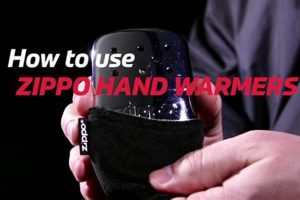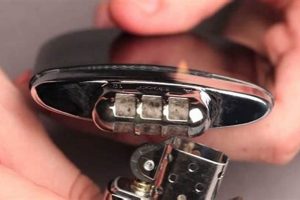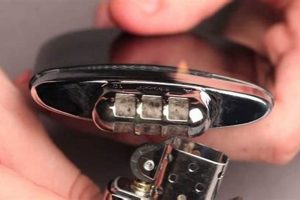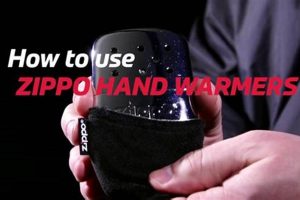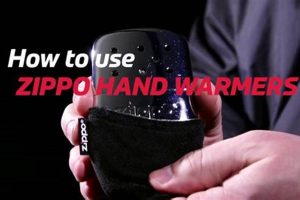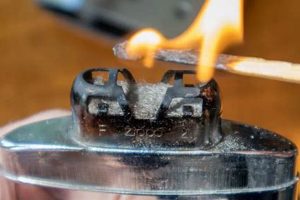Zippo hand warmers utilize a catalytic process to generate heat. A measured amount of lighter fluid, typically sold alongside the warmers, saturates an internal burner pad. This pad, containing a platinum catalyst, facilitates a reaction with oxygen that produces heat without a flame. For optimal performance and safety, filling the warmer to the recommended level, indicated by the fill line, is essential.
The correct fuel volume ensures consistent, long-lasting warmth, typically for several hours depending on the model and environmental conditions. Overfilling can lead to leaks, spills, and potential fire hazards. Underfilling, conversely, results in reduced heat output and shorter periods of warmth. Historically, catalytic hand warmers have provided portable warmth for outdoor enthusiasts and workers in cold climates, offering a reliable alternative to other methods. Their popularity has endured due to their simplicity, reusability, and effectiveness.
The following sections will delve into the specifics of filling a Zippo hand warmer correctly, including practical tips, safety precautions, and troubleshooting common issues. Further exploration will address proper fuel storage, maintenance, and responsible usage.
Tips for Fueling a Zippo Hand Warmer
Proper fueling ensures optimal performance and safe operation of catalytic hand warmers. The following tips provide guidance for achieving consistent heat output while mitigating potential risks.
Tip 1: Consult the Manufacturer’s Instructions: Always refer to the specific instructions provided with the hand warmer model. These instructions detail the recommended fuel type and filling procedures.
Tip 2: Use the Correct Fuel: Utilize only the recommended lighter fluid specifically designed for catalytic hand warmers. Other fuels can damage the burner pad and create safety hazards.
Tip 3: Fill in a Well-Ventilated Area: Perform the filling process outdoors or in a well-ventilated space away from open flames and ignition sources. This precaution minimizes the risk of accidental ignition of fuel vapors.
Tip 4: Measure the Fuel Accurately: Fill the warmer to the designated fill line, typically indicated on the filling cup or the warmer itself. Avoid overfilling or underfilling.
Tip 5: Allow the Burner Pad to Saturate: After filling, allow the burner pad to absorb the fuel completely, typically for a few minutes, before igniting. This ensures consistent heat generation.
Tip 6: Secure the Filler Cap Tightly: Ensure the filler cap is securely closed after filling to prevent leaks and spills.
Tip 7: Store Fuel Safely: Store unused lighter fluid in a cool, dry place away from children and heat sources, following the manufacturer’s storage recommendations.
Adhering to these guidelines ensures safe and effective operation, maximizing the lifespan of the hand warmer and providing reliable warmth in cold environments.
By understanding the principles of safe fueling and operation, users can confidently enjoy the benefits of catalytic hand warmers while minimizing potential risks. The following section will conclude with a brief overview of maintenance and troubleshooting.
1. Fill to designated line.
The instruction “Fill to designated line” is paramount for determining the correct fluid volume in a Zippo hand warmer. This seemingly simple directive plays a crucial role in ensuring safe and efficient operation, directly impacting the warmer’s performance and longevity.
- Safety Implications
Adhering to the designated fill line prevents overfilling, which can lead to fuel leakage and potential fire hazards. Overfilling can also damage the burner pad, reducing its lifespan. Conversely, underfilling results in insufficient fuel for optimal heat output. The fill line provides a critical safety margin, minimizing risks associated with fuel handling.
- Performance Optimization
The designated fill line corresponds to the optimal fuel volume for the specific hand warmer model. This precise amount ensures consistent and sustained heat generation for the intended duration. Filling below the line reduces heat output and operating time, while overfilling does not increase warmth and poses safety risks.
- Longevity and Maintenance
Respecting the fill line contributes to the hand warmer’s longevity. Consistent, measured fueling avoids damage to the burner pad caused by excessive fuel exposure, preserving its catalytic efficiency over time. This practice minimizes the need for replacements and maintenance.
- Environmental Considerations
Filling to the designated line minimizes fuel waste. Precise fueling avoids spills and leaks, reducing the environmental impact associated with improper fuel disposal. This practice promotes responsible resource utilization.
In conclusion, the “Fill to designated line” instruction is not merely a suggestion but a crucial operational parameter. It directly impacts the safety, performance, longevity, and environmental footprint associated with Zippo hand warmer usage. Understanding and adhering to this guideline ensures optimal functionality while mitigating potential risks.
2. Avoid overfilling.
The caution “Avoid overfilling” holds significant weight in the context of fueling a Zippo hand warmer. It represents a crucial safety and operational parameter that directly impacts the user experience and the device’s longevity. Overfilling can lead to a range of undesirable consequences, compromising both safety and performance.
- Safety Hazards
Overfilling creates a surplus of volatile lighter fluid, increasing the risk of spills and leaks. This excess fuel can ignite unexpectedly, posing a fire hazard to the user and surrounding environment. Spilled fuel can also cause skin irritation or damage to surfaces.
- Impaired Performance
Contrary to intuition, overfilling does not enhance heat output. Instead, it can saturate the burner pad excessively, hindering the catalytic process and reducing heat generation. Excess fuel can also block air circulation, further diminishing performance.
- Damage to the Device
Overfilling can damage the hand warmer’s internal components. Prolonged exposure to excess fuel can degrade the burner pad, shortening its lifespan and necessitating premature replacement. Leaking fuel can also damage the warmer’s casing or other components.
- Environmental Impact
Overfilling increases the likelihood of fuel spills, contributing to environmental pollution. Improperly disposed of lighter fluid can contaminate soil and water sources. Adhering to the recommended fill level minimizes fuel waste and reduces the environmental footprint.
In summary, “Avoid overfilling” serves as a critical guideline for safe and effective hand warmer operation. Observing this precaution mitigates safety hazards, ensures optimal performance, prolongs the device’s lifespan, and minimizes environmental impact. Understanding the implications of overfilling underscores the importance of precise fuel measurement and responsible handling.
3. Prevent underfilling.
The directive “Prevent underfilling” is intrinsically linked to the broader topic of how much fluid to put in a Zippo hand warmer. Underfilling, the insufficient saturation of the burner pad with lighter fluid, directly impacts the hand warmer’s functionality and effectiveness. This seemingly minor oversight can lead to several undesirable outcomes, diminishing the user experience and potentially compromising the device’s longevity.
The primary consequence of underfilling is reduced heat output. The catalytic reaction within the hand warmer relies on the proper ratio of fuel and oxygen. Insufficient fuel limits the reaction’s intensity, resulting in lower heat generation. This can be particularly problematic in cold environments where adequate warmth is essential. Furthermore, underfilling shortens the duration of heat production. With less fuel available for combustion, the hand warmer will cool down more rapidly, requiring more frequent refueling and potentially leaving the user without warmth when needed most. For instance, a hand warmer intended to provide heat for 12 hours might only last for a few hours if significantly underfilled. This can be inconvenient during outdoor activities or in situations where access to fuel is limited.
While underfilling might appear less hazardous than overfilling, it nonetheless impacts the overall functionality and efficiency of the hand warmer. Ensuring the correct fuel volume, as indicated by the designated fill line, optimizes heat output and operational duration. Understanding the importance of preventing underfilling contributes significantly to the effective and satisfactory use of a Zippo hand warmer. It complements the broader understanding of proper fueling procedures, which encompass avoiding both underfilling and overfilling to achieve optimal performance and safety. This knowledge empowers users to maximize the benefits of their hand warmers in various conditions and situations.
4. Consult instructions.
The seemingly simple directive “Consult instructions” carries profound implications for the safe and effective use of a Zippo hand warmer. Understanding the rationale behind this instruction is crucial for optimizing performance, mitigating risks, and ensuring user satisfaction. Ignoring provided instructions can lead to operational errors, safety hazards, and reduced device longevity. This section explores the multifaceted importance of consulting the manufacturer’s instructions before and during hand warmer operation.
- Determining the Correct Fuel Type
Instructions specify the appropriate fuel type for the specific hand warmer model. Using incorrect fuel can damage the burner pad, compromise performance, and create safety hazards. For instance, using gasoline instead of Zippo lighter fluid can produce excessive heat and potentially damage the device.
- Understanding the Filling Procedure
Instructions provide detailed guidance on the proper filling procedure, including how to measure and pour the correct amount of fuel, ensuring optimal saturation of the burner pad without overfilling. This prevents leaks, spills, and potential ignition of excess fuel.
- Safe Handling and Operation
Instructions outline essential safety precautions related to fuel handling, ignition, and extinguishing the hand warmer. This information minimizes the risk of burns, fire hazards, and other accidents associated with improper usage. For example, instructions typically advise against filling the warmer near open flames.
- Maintenance and Troubleshooting
Instructions offer guidance on routine maintenance, cleaning procedures, and troubleshooting common issues. This information helps maintain optimal performance and extends the lifespan of the hand warmer. For example, instructions might detail how to clean the burner pad or address issues with ignition.
In conclusion, “Consult instructions” is not merely a suggestion but a crucial prerequisite for the safe, effective, and responsible use of a Zippo hand warmer. Understanding and adhering to the manufacturer’s guidelines ensures optimal performance, mitigates potential risks, and maximizes the device’s lifespan. This proactive approach empowers users to fully utilize the benefits of their hand warmers while minimizing potential hazards and ensuring long-term satisfaction.
5. Use correct fuel.
The directive “Use correct fuel” is inextricably linked to the question of how much fluid to put in a Zippo hand warmer. Fuel type significantly influences the performance, safety, and longevity of the device. Using an incorrect fuel can not only diminish heat output but also pose serious safety hazards and damage the warmer irreparably. This section explores the critical connection between fuel type and optimal hand warmer operation.
- Fuel Compatibility and the Catalytic Process
Zippo hand warmers rely on a catalytic process to generate heat. This process requires a specific type of lighter fluid formulated for optimal interaction with the platinum catalyst. Using other fuels, such as gasoline or white gas, can disrupt the catalytic reaction, producing insufficient heat or even damaging the catalyst, rendering the warmer unusable.
- Safety Implications of Incorrect Fuel
Using the incorrect fuel can create significant safety hazards. Fuels not designed for catalytic hand warmers may burn at higher temperatures, increasing the risk of burns or fires. They may also produce harmful fumes or soot, posing health risks. For example, using gasoline can create a dangerous, uncontrolled flame.
- Impact on Hand Warmer Longevity
The use of incorrect fuel can significantly reduce the lifespan of a Zippo hand warmer. Inappropriate fuels can corrode internal components, damage the burner pad, or clog the fuel lines. This can lead to reduced performance and ultimately necessitate premature replacement of the device. For example, using kerosene can leave deposits that clog the burner.
- Environmental Considerations
Using the correct fuel also has environmental implications. Some fuels produce more pollutants than others when burned. Using the recommended lighter fluid minimizes the environmental impact associated with hand warmer operation. Additionally, damaged hand warmers due to incorrect fuel use contribute to electronic waste.
In conclusion, “Use correct fuel” is not merely a recommendation but a critical requirement for the safe, effective, and sustainable use of a Zippo hand warmer. The choice of fuel directly influences the device’s performance, safety, and longevity. Understanding this connection empowers users to make informed decisions that maximize the benefits of their hand warmers while minimizing potential risks and environmental impact. It underscores the importance of adhering to manufacturer guidelines regarding fuel type, ensuring both user safety and optimal device functionality.
6. Ensure proper saturation.
Ensure proper saturation is a critical step in the operation of a Zippo hand warmer, directly impacting its effectiveness and longevity. It refers to the complete absorption of lighter fluid by the internal burner pad, a process essential for achieving optimal catalytic performance. Insufficient saturation or uneven distribution of fuel within the pad can lead to diminished heat output, shortened operational duration, and potential damage to the device. Understanding the factors contributing to proper saturation is essential for maximizing the hand warmer’s utility and lifespan.
- Fuel Quantity and Saturation Time
The correct amount of fuel, as indicated by the designated fill line, is the foundation of proper saturation. However, simply pouring the correct volume does not guarantee complete absorption. Sufficient time must be allowed for the porous burner pad to fully absorb the fluid. Rushing this process can result in uneven saturation, where some areas of the pad remain dry while others are excessively wet. This can lead to inconsistent heat output and reduced operational efficiency.
- Even Fuel Distribution within the Burner Pad
Even distribution of fuel within the burner pad is crucial for consistent heat generation. Uneven saturation, often caused by insufficient waiting time or improper filling techniques, can result in localized hot spots and reduced overall warmth. This uneven distribution can also stress the burner pad, potentially shortening its lifespan.
- Impact of Environmental Temperature on Saturation
Environmental temperature can influence the saturation process. Lower temperatures can slow down the absorption rate of the lighter fluid into the burner pad, requiring a longer waiting period before activation. Conversely, higher temperatures may accelerate the process. Understanding this interplay between temperature and saturation time is crucial for optimal hand warmer performance in varying conditions.
- Visual Inspection and Confirmation of Saturation
While the recommended waiting time provides a general guideline, visually inspecting the burner pad can offer additional confirmation of proper saturation. After filling and waiting the appropriate duration, a properly saturated pad will appear uniformly darkened by the absorbed fuel. Any dry or significantly lighter areas indicate incomplete saturation, requiring additional waiting time before activation.
In conclusion, “Ensure proper saturation” is not merely a procedural step but a critical factor influencing the effectiveness and longevity of a Zippo hand warmer. Understanding the interplay between fuel quantity, saturation time, even distribution, and environmental temperature empowers users to optimize the performance of their hand warmers. This attention to detail ensures consistent heat output, maximizes operational duration, and contributes to the long-term reliability of the device, thereby enhancing its utility in various situations and conditions.
7. Secure filler cap.
The seemingly simple act of securing the filler cap plays a crucial role in the safe and effective operation of a Zippo hand warmer. This seemingly minor detail is intrinsically linked to the broader question of how much fluid to put in a Zippo hand warmer, as it directly impacts fuel security, preventing leaks and spills that can compromise both safety and performance. A loose or improperly secured filler cap can negate the careful measurement of fuel, rendering the process ineffective and potentially hazardous.
- Leak Prevention and Fuel Security
A securely fastened filler cap creates a sealed environment within the hand warmer, preventing lighter fluid from leaking. This is crucial not only for maintaining the correct fuel level for optimal operation but also for preventing spills that can pose fire hazards or cause skin irritation. A loose cap can allow fuel to escape even if the warmer is not actively in use, potentially emptying the reservoir and rendering the device useless when needed.
- Safety Implications of a Loose Cap
A loose filler cap represents a significant safety hazard. Leaking fuel can ignite easily, posing a risk of burns and fires. The vapors from spilled lighter fluid can also be harmful if inhaled. Moreover, a loose cap increases the risk of accidental ingestion of fuel, particularly if the hand warmer is carried in a pocket or bag.
- Maintaining Optimal Performance
A secure filler cap ensures that the measured amount of fuel remains within the hand warmer, allowing for consistent and predictable heat output. A loose cap, allowing fuel to escape, will result in reduced heat output and shorter operational duration. This can be particularly problematic in cold environments where reliable warmth is essential.
- Environmental Responsibility
Securing the filler cap minimizes the risk of fuel spills, which can have detrimental environmental consequences. Lighter fluid can contaminate soil and water sources. Preventing leaks through a properly secured cap promotes responsible fuel usage and minimizes environmental impact.
In conclusion, the seemingly simple act of securing the filler cap is a critical component of safe and effective hand warmer operation. It directly impacts fuel security, preventing leaks and spills that can compromise both safety and performance. This seemingly small detail is intrinsically connected to the amount of fluid placed within the warmer, as a loose cap negates the careful measurement of fuel. Therefore, understanding the importance of a secure filler cap is essential for maximizing the hand warmer’s utility while minimizing potential risks and environmental impact. It complements the understanding of proper fueling procedures, contributing to a holistic approach to hand warmer usage that prioritizes safety, efficiency, and responsible resource management.
Frequently Asked Questions
This section addresses common inquiries regarding fuel volume for Zippo hand warmers, providing concise and informative responses to clarify potential uncertainties and promote safe and effective usage.
Question 1: How does one determine the correct fuel level for a Zippo hand warmer?
The correct fuel level is indicated by a designated fill line on the filling cup or the warmer itself. Consult the manufacturer’s instructions for specific guidance.
Question 2: What are the consequences of overfilling a Zippo hand warmer?
Overfilling can lead to fuel leaks, spills, and potential fire hazards. It can also damage the burner pad and reduce the device’s lifespan.
Question 3: What happens if a Zippo hand warmer is underfilled?
Underfilling results in reduced heat output and a shorter duration of warmth. It may necessitate more frequent refueling.
Question 4: Can any type of lighter fluid be used in a Zippo hand warmer?
No. Only use the recommended lighter fluid specified by the manufacturer. Using other fuels can damage the warmer and pose safety risks.
Question 5: How long does it take for the burner pad to become fully saturated after filling?
The saturation time typically ranges from a few minutes to several minutes, depending on the model and ambient temperature. Consult the manufacturer’s instructions for specific guidance.
Question 6: Why is it important to secure the filler cap tightly?
A securely fastened filler cap prevents fuel leaks and spills, ensuring safe operation and maintaining the desired fuel level for optimal performance.
Understanding these frequently asked questions contributes significantly to safe and effective hand warmer operation. Precise fuel measurement and adherence to manufacturer guidelines ensure optimal performance and minimize potential risks.
The following section will offer practical tips for maximizing the lifespan of your Zippo hand warmer.
Conclusion
Proper fuel volume is paramount for the safe and effective operation of a Zippo hand warmer. Adhering to the designated fill line, as indicated on the device or its accompanying instructions, ensures optimal heat output and minimizes potential risks. Overfilling poses fire hazards and can damage the device, while underfilling reduces heat output and operational duration. Utilizing the correct fuel type, as specified by the manufacturer, is crucial for both performance and safety. Allowing sufficient time for burner pad saturation and securing the filler cap tightly complete the fueling process, ensuring consistent heat generation and preventing leaks.
Understanding the precise fuel requirements of a Zippo hand warmer contributes significantly to a positive user experience. Proper fueling practices maximize the device’s effectiveness, ensure user safety, and prolong its lifespan. This knowledge empowers users to confidently rely on their hand warmers in various conditions, promoting comfort and safety in cold environments. Ultimately, responsible and informed fuel management unlocks the full potential of this valuable tool.


